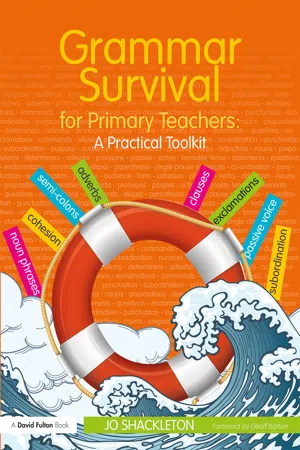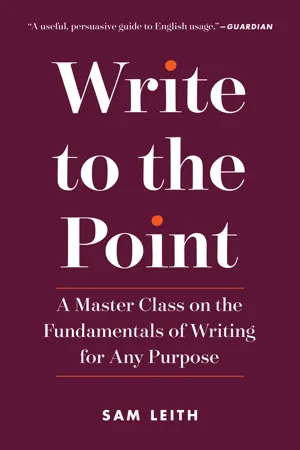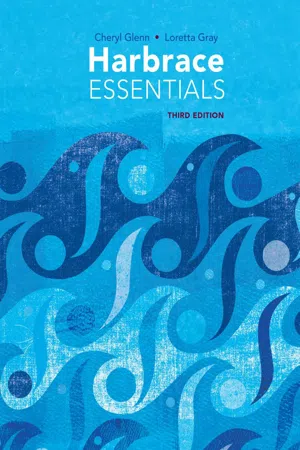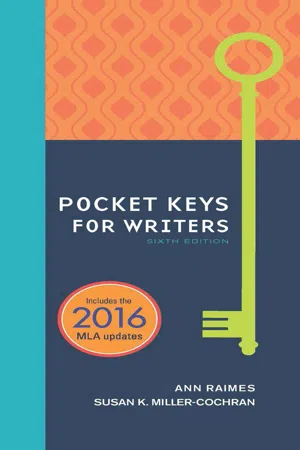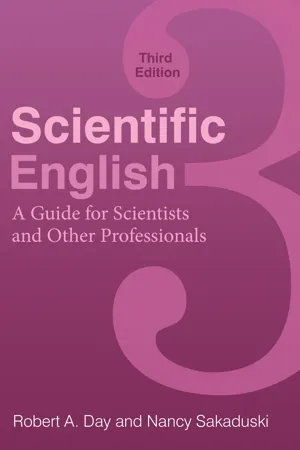Languages & Linguistics
Colons
Colons are punctuation marks used to introduce a list, explanation, or amplification of a previous statement. They can also be used to separate hours and minutes in time notation. In writing, colons help to provide clarity and organization, making it easier for readers to understand the structure and flow of the text.
Written by Perlego with AI-assistance
Related key terms
1 of 5
5 Key excerpts on "Colons"
- eBook - ePub
Grammar Survival for Primary Teachers
A Practical Toolkit
- Jo Shackleton(Author)
- 2017(Publication Date)
- Routledge(Publisher)
p.84 KNOWLEDGE What you need to know about ColonsThe semi-colon was widely used in the eighteenth and nineteenth centuries when long, complex sentence structures were favoured. Today the trend seems to favour shorter and less complex sentence structures, and the semi-colon is less widely used. Very few children’s writers use it. However, it’s a very useful punctuation mark that can convey subtleties of meaning and economy. Because the reader has to work out the link between the clauses, it supports inference and deduction, forging a closer relationship between reader and writer. Many would say that the semi-colon, effectively used, is one mark of a sophisticated writer.A colon is typically used to join two main clauses, with the second clause providing some explanation, elaboration or clarification of the first. Whereas a semi-colon suggests a sense of balance, a colon looks ahead to what comes next.• The teacher knew why Paul was such an engaging writer: he had always been an avid reader. • Tabitha peered out of the window: there was only darkness. • There was much opposition to the new bypass: the potential damage to the countryside was just too great.The national curriculum requires children to learn how to use Colons to mark the boundary between independent clauses, and the sentences above are examples of the way they can do this. However, unlike a semi-colon, the words that follow the colon do not have to be a main clause – they may just consist of a single word. Notice that the words that precede the colon are almost always a main clause, even though the words that follow may be a phrase or just a single word.• The school was facing a major challenge: the recruitment of a new headteacher. • Sandra could think of only one reason for his behaviour: jealousy.In the same way, a colon can also introduce a list. Notice again how the words that precede the colon consist of a main clause:• I have three friends: Charlie, Sandip and Talia. • There were strong arguments in favour of the new supermarket: convenience, greater choice and lower prices.You’ll notice that, unless the colon is introducing a quotation, the words that follow the colon do not normally start with a capital letter (unless, of course, they are proper nouns). Remember that the words that precede the colon should usually be a main clause. The following would be incorrect: - eBook - ePub
Write to the Point
A Master Class on the Fundamentals of Writing for Any Purpose
- Sam Leith(Author)
- 2021(Publication Date)
- The Experiment(Publisher)
It’s worth starting by thinking about exactly what punctuation is for. It’s one of the things, along with word order and morphology (the way words change their forms and endings), that help orient the words in a sentence. Punctuation marks are signposts through a sentence. Some of them inflect a sentence’s tone or meaning: A question mark or an exclamation point change what you might think of as a sentence’s tone of voice. Some of them denote a relationship between one part of a sentence and another: Brackets tell you that what’s in them isn’t part of the main flow of the sentence; a colon signals that what comes after it elaborates or depends on what goes before.Originally, though, punctuation began as a device used by scribes to help people reading aloud know where to pause. The big four marks—the comma, the semicolon, the colon, and the period—were primarily understood to denote the length of a pause, with a period in some accounts of it four times as long as a comma. But those marks were taken up by printers and grammarians and repurposed as aids to semantic understanding. In effect—as with many other features of the language—prescriptive grammarians attempted to fold them into a logically consistent system. So punctuation now plays two parts: It both marks time for the reading voice and signposts grammatical relationships. Many of the arguments about punctuation arise from the overlap between its two functions. A comma can be there simply to mark a pause—but it can also have a role in marking a parenthesis or separating two clauses. As the linguist David Crystal writes in his book Making a Point: The Pernickety Story of English Punctuation: “This is where we see the origins of virtually all the arguments over punctuation that have continued down the centuries and which are still with us today.”Punctuation is also subject to fashion. We live in an age that favors light punctuation. We use fewer commas than our forebears. We omit periods at the ends of sentences in many circumstances—in the titles of books, on signposts, and in text messages or social media posts. We are more likely to do away with hyphens when writing compound words—preferring “semicolon” to “semi-colon,” for instance. - eBook - PDF
- Cheryl Glenn, Loretta Gray(Authors)
- 2018(Publication Date)
- Cengage Learning EMEA(Publisher)
Copyright 2019 Cengage Learning. All Rights Reserved. May not be copied, scanned, or duplicated, in whole or in part. Due to electronic rights, some third party content may be suppressed from the eBook and/or eChapter(s). Editorial review has deemed that any suppressed content does not materially affect the overall learning experience. Cengage Learning reserves the right to remove additional content at any time if subsequent rights restrictions require it. 380 32b The Semicolon and the Colon (2) Signallng that a list follows A colon can be used to introduce a list. Note that an indepen-dent clause precedes the list. ➤ The website provides statistics for three states : Washington, Oregon, and Idaho. Avoid placing a colon between a verb and its complement or after the words including and such as . ➤ The website provides statistics for many states including : Washington, Oregon, and Idaho. ➤ The website provides statistics on topics such as : population and education. (3) Separating a title and a subtitle Use a colon between a work’s title and its subtitle. The Sixth Extinction : An Unnatural History (4) Speciallzed uses in business correspondence A colon follows the salutation of a business letter and any notations. Dear Dr. Horner : Enc : A colon introduces the headings in a memo. To : From : Subject : Date : (5) Separating elements in reference numbers Colons are often used between numbers in scriptural references. Psalms 3 : 5 Gen. 1 : 1 However, MLA requires the use of periods instead of Colons. Psalms 3 . 5 Gen. 1 . 1 Copyright 2019 Cengage Learning. All Rights Reserved. May not be copied, scanned, or duplicated, in whole or in part. Due to electronic rights, some third party content may be suppressed from the eBook and/or eChapter(s). Editorial review has deemed that any suppressed content does not materially affect the overall learning experience. - Ann Raimes, Susan Miller-Cochran(Authors)
- 2017(Publication Date)
- Cengage Learning EMEA(Publisher)
2. after an independent clause to introduce an explana-tion, expansion, or elaboration After an alarming cancer diagnosis and years of treatment, Lance Armstrong was victorious: he won the Tour de France seven times. Some writers prefer to use a capital letter after a colon introducing an independent clause. Be consistent in your usage. 3. to introduce a rule or principle, which may begin with a capital letter The main principle of public speaking is simple: Look at the audience. 4. to introduce a quotation that is not integrated into your sentence and not introduced by a verb such as Oscar Wilde makes the point well: “The real schools should be the streets.” A colon also introduces a long quotation set off from your text (see 8c). 5. in salutations, precise time notations, biblical cita-tions, and within titles Dear Chancellor Witkin: 7:20 p.m. To: The Chancellor Genesis 37:31–35 Isamu Noguchi: A Sculptor’s World [book title and subtitle] 30d 228 Dashes, Parentheses, Slashes, and Brackets Do not use a colon directly after a verb (such as a form of be or include ); after expressions such as for example, espe-cially , and such as ; or after a preposition. The book includes a preface, an introduction, an appendix, and an index. They packed many foods for the picnic, such as tortilla chips, salsa, and three-bean salad. His taste is so varied that he furnishes his living room with antiques, modern art, and art deco lighting fixtures. 30d Dashes, parentheses, slashes, and brackets Dashes (—) set off material that is inserted into a sentence. Type a dash or two hyphens with no extra space before, after, or between them. (Software will automatically con-vert two hyphens to a dash as you type.) Armed with one weapon—his wit—he set off. Commas can sometimes be used to set off inserted material, too, but when the insertion itself contains com-mas, dashes are preferable.- eBook - PDF
Scientific English
A Guide for Scientists and Other Professionals
- Robert A. Day, Nancy Sakaduski(Authors)
- 2011(Publication Date)
- Greenwood(Publisher)
There is one thing that can prevent caries: sealants. I have had my results for a long time: but I do not yet know how I am to arrive at them. —Karl Friedrich Gauss Orgel’s Second Rule: Evolution is cleverer than you are. —Francis Crick Punctuation 141 The colon often introduces a list. However, words like the following should be used to signal to the reader that a list is coming. Wrong: The lab order included: flasks and Red Bull. Right: The lab order included the following: flasks and Red Bull. Also Right: The lab order included flasks and Red Bull. Grammatically, the first sentence is incorrect because the colon separates a verb from its object. In the second example, “the following” becomes the object, and “flasks and Red Bull” becomes an appositive. A colon is used after a clause that would be a sentence on its own. Graduate students are like cats: they are creatures of the night, can sleep almost anywhere, and show a lack of respect for authority. Rarely, a colon is used in place of a semicolon to separate two independent clauses. This is done when the second clause has a strong relationship to the first. Publicity is like poison: it doesn’t hurt unless you swallow it. —Joe Paterno A semicolon would not be incorrect in this example, but the colon does a better job of unifying the two clauses. Colons are often used to separate a book, chapter, or article title from a subtitle; a semicolon, though often used in these instances, is incorrect. Scientific English: A Guide for Scientists and Other Professionals The only other uses of the colon are certain conventional uses, such as at the end of salutations in letters, in between hours and minutes, and in ratios. Dear John: 2:30 a.m. 1:3 1:3::2:6 142 Scientific English HYPHENS The hyphen has a number of uses, most of them confusing. Hyphens are used to indicate end-of-line word division in printed materials.
Index pages curate the most relevant extracts from our library of academic textbooks. They’ve been created using an in-house natural language model (NLM), each adding context and meaning to key research topics.
